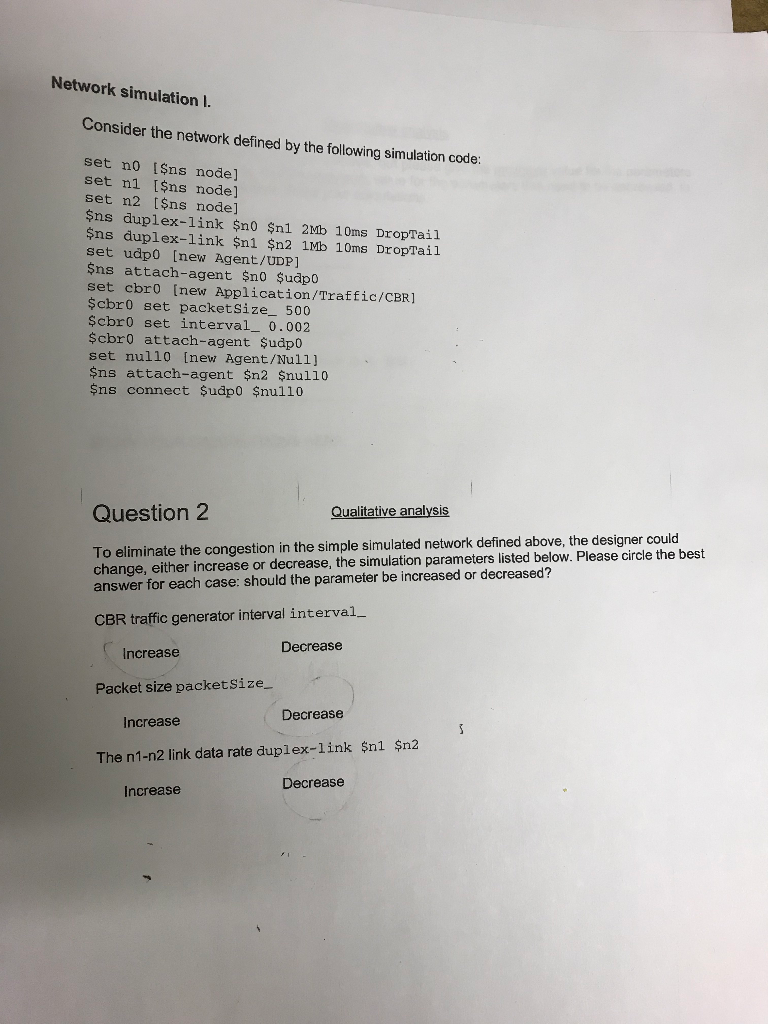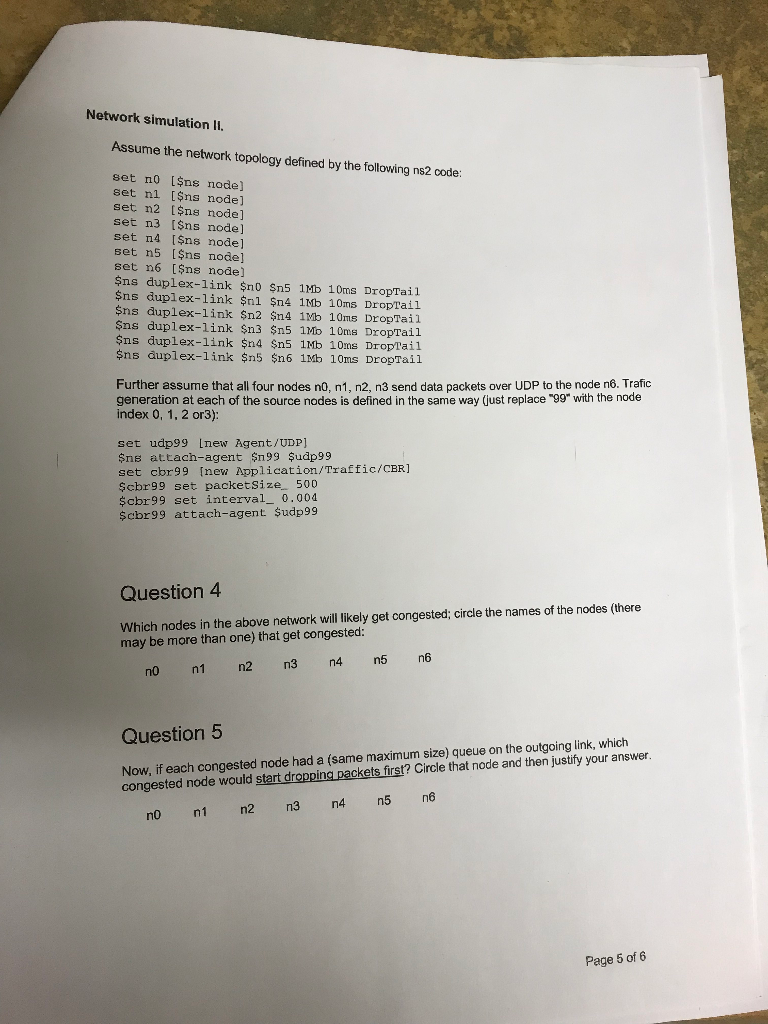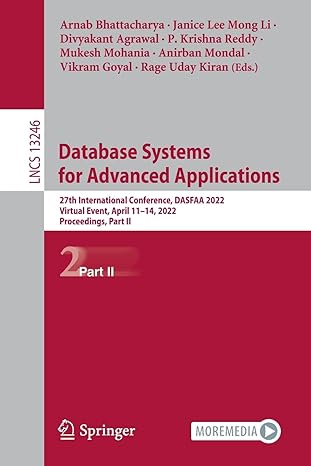Network Modelling, Computer Science



Network simulation I. Consider the network defined by the following simulation code: set no ISns node] set nl I$ns node] set n2 [$ns node] Sns duplex-link $n0 Sn1 2b 10ms DropTail Sns duplex-link $n1 $n2 1Mb 10ms DropTail set udp0 [new Agent/UDP] $ns attach-agent $n0 $udp0 set cbr0 [new Application/Traffic/CBR] $cbr0 set packetSize 500 Scbr0 set interval_ 0.002 Scbr0 attach-agent $udp0 set null0 [new Agent/Null] Sns attach-agent $n2 Snul10 $ns connect $udpo snul10 Question 2 Qualitative analysis To eliminate the congestion in the simple simulated network defined above, the designer could change, either increase or decrease, the simulation parameters listed below. Please circle the answer for each case: should the parameter be increased or decreased? best CBR traffic generator interval interval Decrease Increase Packet size packetSize_ Decrease Increase The n1-n2 link data rate duplex-link $nl Sn2 Decrease Increase Question 3 Quantitative analysis Problem is the same as in Question 2 above, but please give the minimum value for the parametars that need to be increased a order to eliminate congestion. Show your calculations. CBR traffic generator interval interval_ Value: Packet size packetsize_ Value: The n1-n2 link data rate duplex-link Snl $n2 Value: SHOW YOUR CALCULATIONS HERE: Network simulation li Assume the network topology defined by the following ns2 code set n0 I$ns node] set nl Sns node] set n2 Sns node] set n3 [Sns node] set n4 ISns node] set n5 $ns node] set n6 Sns node] Sns duplex-link $n0 Sn5 1Mb 10ms DropTail $ns duplex-link $nl $n4 1Mb 10ms DropTail Sns duplex-link Sn2 $n4 1Mb 10ms DropTail Sns duplex-link Sn3 $n5 1Mo 10ms DropTail $ns duplex-link $n4 $n5 1Mb 10ms DropTail $ns duplex-link Sn5 $n6 1Mb 10ms DropTail Further assume that all four nodes n0, n1, n2, n3 send data packets over UDP to the node n6. Trafic generation at each of the source nodes is defined in the same way (just replace "99" with the node index 0, 1, 2 or3): set udp99 Inew Agent/UDP] $ns attach-agent $n99 udp99 set cbr99 new Application/Traffic/CBR] $cbr99 set packetsize 500 $cbr99 set interval_ 0.004 scbr99 attach-agent $udp99 Question4 Which nodes in the above network will likely get congested; circle the names of the nodes (there may be more than one) that get congested no n1 n2 n3 n4 n5 n6 Question 5 Now, if each congested node had a (same maximum size) queue on the outgoing link, which congested node would start dropping packets first? Circle that node and then justify your answer. no n1 n2 n3 n4 n5 n6 Page 5 of 6 Network simulation I. Consider the network defined by the following simulation code: set no ISns node] set nl I$ns node] set n2 [$ns node] Sns duplex-link $n0 Sn1 2b 10ms DropTail Sns duplex-link $n1 $n2 1Mb 10ms DropTail set udp0 [new Agent/UDP] $ns attach-agent $n0 $udp0 set cbr0 [new Application/Traffic/CBR] $cbr0 set packetSize 500 Scbr0 set interval_ 0.002 Scbr0 attach-agent $udp0 set null0 [new Agent/Null] Sns attach-agent $n2 Snul10 $ns connect $udpo snul10 Question 2 Qualitative analysis To eliminate the congestion in the simple simulated network defined above, the designer could change, either increase or decrease, the simulation parameters listed below. Please circle the answer for each case: should the parameter be increased or decreased? best CBR traffic generator interval interval Decrease Increase Packet size packetSize_ Decrease Increase The n1-n2 link data rate duplex-link $nl Sn2 Decrease Increase Question 3 Quantitative analysis Problem is the same as in Question 2 above, but please give the minimum value for the parametars that need to be increased a order to eliminate congestion. Show your calculations. CBR traffic generator interval interval_ Value: Packet size packetsize_ Value: The n1-n2 link data rate duplex-link Snl $n2 Value: SHOW YOUR CALCULATIONS HERE: Network simulation li Assume the network topology defined by the following ns2 code set n0 I$ns node] set nl Sns node] set n2 Sns node] set n3 [Sns node] set n4 ISns node] set n5 $ns node] set n6 Sns node] Sns duplex-link $n0 Sn5 1Mb 10ms DropTail $ns duplex-link $nl $n4 1Mb 10ms DropTail Sns duplex-link Sn2 $n4 1Mb 10ms DropTail Sns duplex-link Sn3 $n5 1Mo 10ms DropTail $ns duplex-link $n4 $n5 1Mb 10ms DropTail $ns duplex-link Sn5 $n6 1Mb 10ms DropTail Further assume that all four nodes n0, n1, n2, n3 send data packets over UDP to the node n6. Trafic generation at each of the source nodes is defined in the same way (just replace "99" with the node index 0, 1, 2 or3): set udp99 Inew Agent/UDP] $ns attach-agent $n99 udp99 set cbr99 new Application/Traffic/CBR] $cbr99 set packetsize 500 $cbr99 set interval_ 0.004 scbr99 attach-agent $udp99 Question4 Which nodes in the above network will likely get congested; circle the names of the nodes (there may be more than one) that get congested no n1 n2 n3 n4 n5 n6 Question 5 Now, if each congested node had a (same maximum size) queue on the outgoing link, which congested node would start dropping packets first? Circle that node and then justify your answer. no n1 n2 n3 n4 n5 n6 Page 5 of 6









